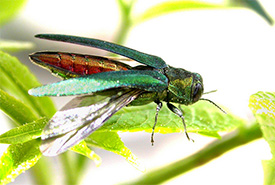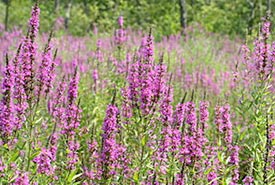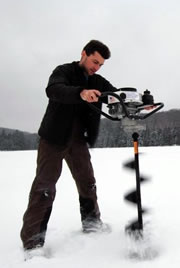Can battling invasive species be a mistake? (Part Two)

Emerald ash borer adult (Photo by by U.S. Department of Agriculture)
In Part One, I discussed the prevalence of invasive species in contemporary ecosystems and questioned whether we should even spend time and resources battling them. I also discussed the "Tens Rule" in invasion biology, which suggests that only a small proportion of non-native species have negative effects on native ecosystems.
So why should we be concerned with invasive species?
There are several reasons why the assumption inherent in the Tens Rule is flawed. The first is that ecological effects are very difficult to detect.
Take for instance an example of introduced trout reducing the abundance of spiders — an odd relationship on the surface. When introduced to streams in the Rocky Mountains, brook trout feed more voraciously on aquatic insects than native cutthroat trout. This reduces the number of insects that hatch and fly into the surrounding forests, limiting how much food is available to the spiders that live nearby. As a result, the abundance of spiders living along side streams with introduced brook trout actually decreases.8
Other ripple effects likely exist, but food webs are complex and difficult to understand. Most people would not think to look for effects of trout on spiders, nor would this relationship be noticed without a carefully controlled study. Many other non-native species probably have effects that we simply have not yet detected.
The other issue is that non-native species can be considered ticking "time bombs."9 They may be seemingly harmless for generations before a change in conditions provides the right opportunity for them to flourish, often at the expense of native competitors or prey.
Take for instance the hemlock woolly adelgid, which is currently wiping out hemlocks south of Pennsylvania. We are fortunate in Canada; our winters are too cold for the adelgid to thrive, at least for now. This species, which is not native to North America, was first observed in an urban park in Richmond, Virginia in the 1950s, and may have been there for decades before it was noticed.10 At first, the species was not considered a major pest, but decades later major outbreaks started to occur, and the adelgid now decimates hemlocks throughout the southeastern U.S.
Those who conclude that only 10 percent of established species have negative effects on recipient ecosystems are naively thinking in human time, rather than evolutionary time. Remember that most introductions have occurred over the past 150 years, especially the last 50 years, which is but a blink of an eye in the evolution of biological communities. The cards are still being dealt, and the chips will continue to fall long after our own generation is gone. There will certainly be some winners, but evidence is mounting that there will be many more losers as a new equilibrium is reached.11

Purple loosestrife (Photo by Liz West, Wikimedia Commons)
All of this is not to suggest that a preference for native species over non-native species is not a matter of human opinion and value. At the Nature Conservancy of Canada (NCC), we acknowledge that biodiversity is being lost, and we are working to prevent this. Our mission is to conserve Canada’s natural heritage, and there is no question that non-native species are among the main threats to it.
As such, when we work to control invasive species, we are expressing a human preference for maintaining the uniqueness and diversity of Canada’s ecosystems over the alternative: a homogenous community of species that can be found throughout the globe.
This isn’t to say that we pull up every weed that is not native to the properties that we manage. To do so would be prohibitively expensive. Our resources are always limited relative to the task we face, and we must spend them judiciously. Certain conditions lend themselves well to using invasive species control as a conservation strategy.
First, the species must have known major negative effects on the local ecosystem. Though all non-native species have the potential to become problematic, resources must be focused on the greatest threats. Second, cost-effective control strategies must be available to deal with the particular species; otherwise, resources are better spent where threats can be meaningfully reduced.
Preventing the spread of invasive species is often the most effective way of reducing their effects, and we engage in outreach and education to help prevent introductions. In some instances, small populations can be eliminated entirely. This is most likely to be possible when new invasions are detected early on, and can require considerable resources but may be less costly than controlling the species in perpetuity.
As with other conservation strategies, NCC is committed to learning more about the effects of the non-native species that we manage, and the most cost-effective ways of preventing their spread and controlling their populations. If we hope to conserve Canada’s natural heritage, doing nothing is not an option.
References
8. Benjamin, J. R., Fausch, K. D., & Baxter, C. V. (2011). Species replacement by a nonnative salmonid alters ecosystem function by reducing prey subsidies that support riparian spiders. Oecologia, 167, 503-512.
9. Courtenay Jr, W. R., Collette, B. B., Essington, T. E., Hilborn, R., Orr, J. W., Pauly, D., Randall, J. E., & Smith-Vaniz, W. F. (2009). Risks of introductions of marine fishes: reply to Briggs. Fisheries, 34, 181-186.
10. Souto, D., Luther, T., Chianese, B., Salom, S. M., Tigner, T. C., & Reardon, R. C. (1996). Past and current status of HWA in eastern and Carolina hemlock stands. Proceedings of the first hemlock woolly adelgid review. Charlottesville, Virginia, USA. 12 October 1995. pp. 9-15.
11. McKinney, M. L., & Lockwood, J. L. (1999). Biotic homogenization: a few winners replacing many losers in the next mass extinction. Trends in ecology & evolution, 14, 450-453.


